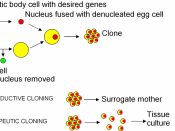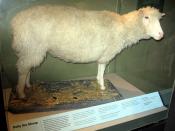What is a clone? The National Bioethics Organisation defines cloning as "the product of creating duplicates of molecules, DNA, cells, tissue and even entire organisms."
Human cloning is the process of asexual reproduction of a human during anytime in the patient's life, and if tissue remains, for many years after the patient has deceased. A human clone is defined as an identical replica of a person with a time delay. Although the appearance of the human clone might look the same, due to the environment of the clones upbringing the personality will most likely differ from the original patient that was cloned. Over the past years cloning has been looked at in awe, though as the years have progressed and scientists have slowly uncovered more and more facts about the mysteries of cloning and the benefits of it more and more protest have been aroused against cloning due to the ethics behind it.
On July 5th 1996 the ewe named dolly became the first mammal to be successfully cloned from an adult stem cell. She was created at the Roslin Institute in Scotland and lived there until her death nearly seven years later. Scientists did not announce her birth until February 22, 1997, however. The process used to clone Dolly, which was made famous by her birth was somatic cell nuclear transfer, in which the nucleus from one of the donor's non-reproductive cells, is placed into a de-nucleated embryonic cell (which is then coaxed into developing into a fetus). When Dolly was cloned in 1996 from a cell taken from a 6 year old ewe, she became the centre of a controversy that still continues today. April 9th 2002, her stuffing is placed at Edinburgh Royal Museum. In 1999, research was published in the journal Nature, suggesting that Dolly may...


